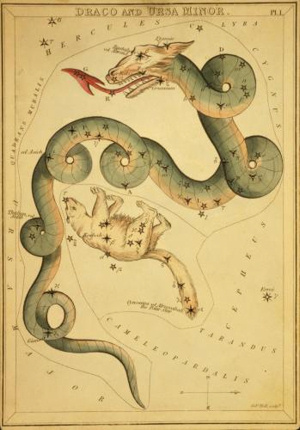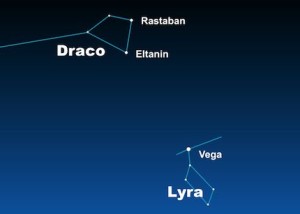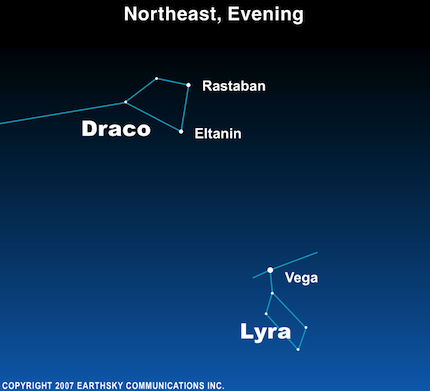
Find out more about Eltanin and Rastaban: Dragon's Eyes
For years, I’ve glanced up in the north at this time of year and spied the two stars marked on today’s chart, Rastaban and Eltanin in the constellation Draco. They’re noticeable because they’re relatively bright and near each other. There’s always that split-second when I ask myself with some excitement what two stars are those? It’s then that my eyes drift to blue-white Vega nearby . . . and I know, by Vega’s nearness, that they are the stars Rastaban and Eltanin. These two stars represent thefiery Eyes of the constellation Draco the Dragon.
In other words – because the stars stay fixed relative to each other – Vega is always near these stars. Vega, by the way, lodges at the apex of the Summer Triangle, a famous pattern consisting of three bright stars in three separate constellations, also prominent at this time of year.
From tropical and subtropical latitudes in the Southern Hemisphere, the stars Rastaban and Eltanin shine quite low in the northern sky (below Vega). In either hemisphere, at all time zones, the Dragon’s eyes climb highest up in the sky around midnight (1 a.m. daylight-saving time) in mid-June, 11 p.m. (midnight daylight-saving time) in early July and 9 p.m. (10 p.m. daylight-saving time) in early August. But from temperate latitudes in the Southern Hemisphere (southern Australia and New Zealand), the Dragon’s eyes never climb above your horizon but you can catch the star Vega way low in your northern sky.
People at mid-northern latitudes get to view the Dragon’s eyes all night long!

Draco the Dragon. Image credit: Old Book Image Art Gallery
Speaking of Rastaban and Eltanin, one of you asked
What are constellations?
The answer is that they’re just patterns of stars on the sky’s dome. The Greeks and Romans, for example, named them for their gods and goddesses, and also for many sorts of animals. In the 20th century, the International Astronomical Union (IAU) formalized the names and boundaries of the constellations. Now every star in the sky belongs to one or another constellation.
The stars within constellations aren’t connected, except in the mind’s eye of stargazers. The stars in general lie at vastly different distances from Earth. It’s by finding juxtaposed patterns on the sky’s dome that you’ll come to know the constellations – much as I identify Rastaban and Eltanin at this time of year by looking for the star Vega.
Eltanin and Rastaban are the Dragon’s eyes
 Stars Eltanin and Rastaban, near bright star Vega
|
|
Our human eyes and brains tend to pick out pairs of stars on the dome of night, especially if the two stars are relatively bright. Few such couplings represent true partner stars in space, however; rarely are the two stars gravitationally bound. Some well-known stellar pairs that are not truly bound include the two stars of the constellation Gemini the Twins – Castor and Pollux – as well as the Little Dipper’s bowl stars Kochab and Pherkad. On Northern Hemisphere summer nights, another famous pair of stars glares down at us from up high in the northern sky. These stars are Eltanin and Rastaban. They represent the fiery Eyes of the constellation Draco the Dragon. Like many pairs of stars, these two look close together only because they are aligned on nearly the same line of sight, as seen from Earth.
Eltanin and Rastaban mark the head of Draco the Dragon. The long and winding star figure of Draco can be found in the northern sky on northern summer evenings. If you have a dark country sky, look for the Dragon’s tail to snake in between the Big and Little Dippers.
If you’re in a city or suburb, look for Eltanin and Rastaban near bright star Vega in the constellation Lyra. Do you know the Summer Triangle? If so, draw an imaginary line from the star Altair through the star Vega to find the Dragon’s eyes glaring at you from high overhead on July evenings and at nightfall in August.
Draco, with Ursa Minor or the Little Dipper, as depicted in Urania’s Mirror, a set of constellation cards published in London c. 1825.
The Dragon’s eyes appear in the northeast sky on spring evenings, nearly overhead on late summer evenings and in the northwest evening sky in late autumn and early winter.
Modern astronomy has determined that the star Rastaban lies well over 200 light-years farther away than its counterpart in Draco, Eltanin. Best estimates place Eltanin at 148 light-years and Rastaban at 362 light-years distant.
As seen from Earth, Eltanin appears as the brighter star, but that’s because it’s so much closer to us than Rastaban. If these stars were the same distance away, Rastaban would shine some six times more brightly than Eltanin, and we’d probably no longer see the two stars as the Dragon’s Eyes.
Eltanin looms large in the history of astronomy. James Kaler has written on his website:
In attempting to find stellar parallax, the annual shift in stellar position caused by the shifting position of the orbiting Earth (from which we get stellar distance), in 1728 James Bradley discovered an “aberration of starlight,” which is caused by the velocity of the moving Earth relative to the speed of the light coming from the star. The discovery once and for all proved that Copernicus was right and that the Earth truly does move around the central sun.Eltanin is the Gamma star in its constellation Draco, and yet it is Draco’s brightest star. It outshines Rastaban (Beta Draconis) and also outshines Thuban (Alpha Draconis). Why does Thuban have the Alpha designation in Draco? It’s because Thuban is a former pole star!
Big and Little Dippers: noticeable in northern sky
